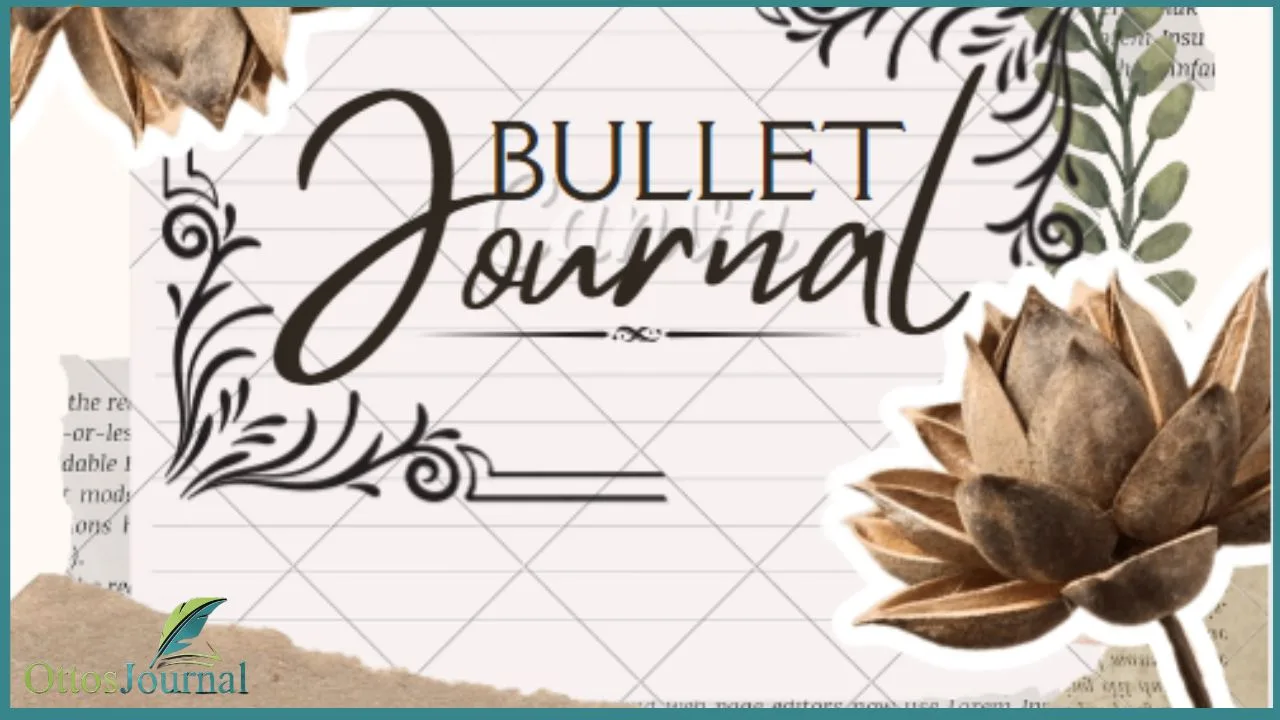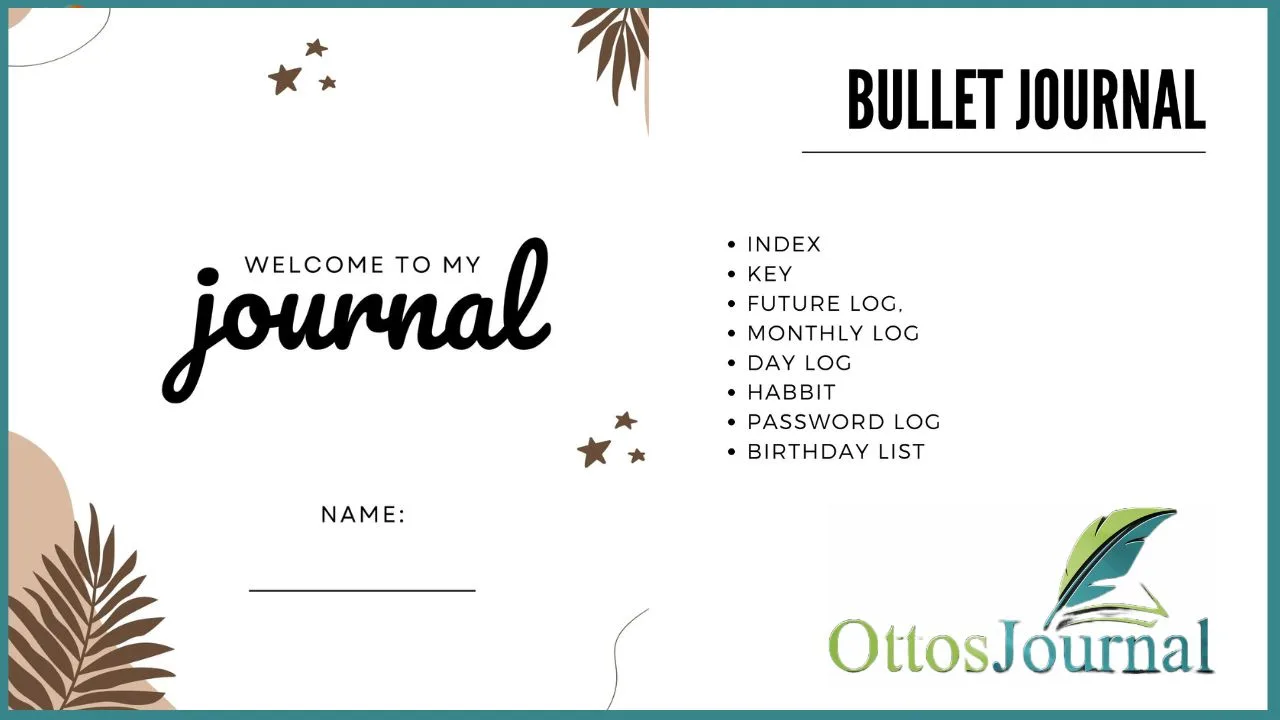Bullet journals are becoming more and more popular for personal organization, but they can also be an incredibly useful tool for work. With a little bit of planning and creativity, a bullet journal can help keep track of work tasks, deadlines, meetings, and notes all in one place.
One of the first steps in using a bullet journal for work is to create an index page. This will help keep track of certain categories and keys if you plan to use them in your spread. You can also section off your journal into particular categories such as work, personal, and health. Keeping a bullet journal definitely helps to break down tasks during the day and remember things better when they are written down on paper.
Bullet Journal Basics
Understanding the Bullet Journal System
A bullet journal is a customizable and flexible system that can be used for a variety of purposes, including work. It was created by Ryder Carroll as a way to help people organize their lives and tasks in a simple and efficient way. The system is based on a few basic principles – rapid logging, migration, and collections.
Rapid logging is the process of quickly jotting down tasks, events, and notes in a simple and concise way. This can be done using bullets, symbols, and short phrases. Migration is the process of reviewing your tasks and notes on a regular basis and moving them to a new page or collection if necessary. Collections are groups of related tasks or notes that are organized together in a specific way.
Choosing Your Bullet Journal
When choosing a bullet journal for work, it is important to consider your specific needs and preferences. There are many different types of notebooks available, but the most popular ones for bullet journaling are dot grid notebooks. These notebooks have a dot grid pattern that allows for easy customization and flexibility.
Other factors to consider when choosing a bullet journal include size, paper quality, and binding. A larger notebook may be more suitable for work, as it provides more space for notes and tasks. Paper quality is also important, as it affects how well your writing and symbols will show up on the page. Finally, binding is a personal preference – some people prefer spiral-bound notebooks, while others prefer hardcover or softcover notebooks.
Bullet Journal Key and Symbols
The key and symbols used in a bullet journal are an essential part of the system. They allow you to quickly and easily identify tasks, events, and notes at a glance. The most common symbols used in a bullet journal include:
- Bullet point (•) for tasks
- Circle (O) for events
- Dash (-) for notes
- Forward arrow (→) for migrated tasks
- Backward arrow (←) for scheduled tasks
In addition to these basic symbols, you can create your own symbols for specific tasks or events. It is also important to create a key that explains the symbols you are using in your bullet journal. This will help you and others understand what each symbol represents.
Setting Up Your Bullet Journal for Work
When setting up a bullet journal for work, there are a few key components to consider. The index page and future log, monthly and weekly spreads, and daily logs and task lists are all important features to include in your bullet journal.
Index Page and Future Log
The index page is a crucial part of your bullet journal as it helps you keep track of important information. It is recommended to create an index page at the beginning of your journal and number each page. This will allow you to easily find specific information later on.
The future log is also an important feature to include in your bullet journal. It is a place where you can write down important dates, events, and deadlines that are coming up in the future. This will help you plan ahead and stay organized.
Monthly and Weekly Spreads
Monthly spreads are a great way to get an overview of your schedule for the month. You can create a calendar spread where you can write down important dates, events, and deadlines for the month. This will help you plan ahead and stay on top of your schedule.
Weekly spreads are also important to include in your bullet journal. They allow you to break down your schedule for the week and prioritize tasks. You can create a to-do list for the week and assign each task a priority level.
Daily Logs and Task Lists
Daily logs are where you can write down important tasks, events, and deadlines for the day. You can also include notes and reminders to help you stay on track. Task lists are another important feature to include in your bullet journal. They allow you to prioritize tasks and make sure you are completing the most important tasks first. You can also assign each task a deadline and check them off as you complete them.
Setting up a bullet journal for work can be a great way to stay organized and on top of your schedule. By including an index page and future log, monthly and weekly spreads, and daily logs and task lists, you can ensure that you are staying on track and completing tasks on time.
Bullet Journal Ideas For Work
Here are 20 bullet journal ideas specifically tailored for enhancing productivity at work, along with instructions on how to implement each:
- Work Task Master List: Create a master list of all work tasks, categorizing them by project or priority. Regularly review and update this list to reflect new tasks and completed items.
- Project Milestones: For each project, list key milestones and their deadlines. Break down each milestone into smaller tasks to make progress manageable and trackable.
- Meeting Minutes: Dedicate a section for recording meeting notes. Include the date, attendees, main discussion points, decisions made, and action items, along with who is responsible for each action.
- Professional Development Tracker: Set goals for your professional growth, such as skills to learn or certifications to achieve. Track your progress and log hours spent on professional development activities.
- Work Schedule: Visualize your work hours by creating a weekly schedule spread. Block out time for focused work, meetings, and breaks to manage your time effectively.
- Email Log: Keep a log of important emails that require action. Note the sender, subject, and a deadline for your response to ensure timely communication.
- Client/Customer Profiles: If your work involves clients or customers, maintain a section with key information about them, including contact details, preferences, and past interactions.
- Priority Matrix: Draw a quadrant and label them as urgent/important, not urgent/important, urgent/not important, and not urgent/not important. Place tasks in the appropriate quadrant to prioritize effectively.
- Brainstorming Pages: Reserve space for brainstorming sessions. Use mind maps, bullet points, or sketches to flesh out ideas and strategies.
- Conference or Event Planning: For organizing events or preparing for conferences, list tasks, deadlines, materials needed, and people to contact.
- Annual Goals: At the start of the year, outline your key professional goals. Break them down into quarterly and monthly objectives to keep them actionable.
- Inbox Zero Tracker: Create a daily or weekly tracker to monitor your progress towards maintaining an empty email inbox, which can help reduce stress and improve focus.
- Skill Improvement Log: Choose a skill to improve and track your daily or weekly efforts to enhance it. Note resources used and progress made.
- Work Habit Tracker: Identify work habits you want to cultivate or break. Track your consistency in maintaining or avoiding these habits.
- Daily Focus: Each day, identify a single task or goal that is your main focus. This helps ensure that high-priority work gets done.
- Delegation List: Keep track of tasks you’ve delegated, to whom, and the due date. This helps you follow up appropriately and maintain accountability.
- Time Audit: Log how you spend your time at work for a week to identify areas where you can improve efficiency or eliminate time-wasters.
- Contacts List: Maintain a list of professional contacts, including names, positions, and how they can be reached. Add notes about past interactions or future follow-up points.
- Resource Inventory: Create an inventory of work resources, such as software licenses, access codes, or key documents, for easy reference.
- End-of-Day Review: At the end of each workday, take a few minutes to reflect on what you accomplished, what challenges you faced, and what you need to prioritize for the next day.
Implementing these bullet journal ideas for work can help you stay organized, prioritize your workload, and keep track of your professional development and achievements. Tailor these concepts to fit your job’s unique demands and your personal work style for the best results.

Efficient Task Management
Efficient task management is an essential skill for any worker, and a bullet journal can be a valuable tool in this regard. By using a bullet journal, you can prioritize tasks, deadlines, and projects, and track your progress in an organized manner. Here are some ways that a bullet journal can help with efficient task management.
Prioritizing Tasks and Deadlines
One of the most important aspects of task management is prioritization. A bullet journal can help you prioritize your tasks and deadlines by using symbols and color coding. For example, you can use a star symbol to indicate urgent tasks or deadlines, and a dot symbol to indicate less urgent tasks.
Time-Blocking and Time Management
Time-blocking is a technique where you allocate specific blocks of time for specific tasks. This technique can be useful in managing your time and increasing productivity. A bullet journal can help you implement time-blocking by creating a schedule for your day or week. You can also use a timer to keep track of your time.
Project Management and Progress Tracking
A bullet journal can also be useful in project management and progress tracking. You can create a page for each project and include details such as the project’s scope, goals, and deadlines. You can also use symbols and color coding to track your progress and identify areas that need more attention.
A bullet journal can be a valuable tool for efficient task management. By prioritizing tasks and deadlines, implementing time-blocking, and tracking progress, you can increase productivity and reduce stress.
Integrating Personal and Professional Life
Bullet Journaling is a great way to integrate personal and professional life. It is a flexible system that can be customized to meet individual needs. Here are some ways to use bullet journals for integrating personal and professional life.
Health and Fitness Tracking
Bullet journals can be used to track health and fitness goals. One can create a section to track daily workout routines, steps taken, and water intake. It can also be used to track weight loss progress, and create a meal plan. By keeping track of your health and fitness goals, you can stay motivated and work towards your goals.
Meal Planning and Budgeting
Bullet journals can be used to create a meal plan and track expenses. One can create a section to plan meals for the week, and create a grocery list. It can also be used to track expenses, and create a budget. By keeping track of your expenses, you can make informed decisions and save money.
Mindfulness and Personal Goals
Bullet journals can be used to track personal goals and practice mindfulness. One can create a section to write down personal goals and track progress. It can also be used to practice mindfulness by writing down positive affirmations, and gratitude lists. By practicing mindfulness, one can reduce stress and improve mental health.
Bullet Journaling is a great way to integrate personal and professional life. By using bullet journals to track health and fitness goals, create a meal plan, and track expenses, one can stay organized and focused. By practicing mindfulness and tracking personal goals, one can improve mental health and reduce stress.
Advanced Bullet Journal Techniques
Custom Collections and Creativity
Bullet journals are highly customizable, which means that users can create custom collections that fit their specific needs. A collection is a group of related items that can be organized in a single page or spread. For example, a user can create a collection of business expenses, which can include receipts, invoices, and other financial documents. This can help users keep track of their expenses and make it easier to file their taxes.
Bullet journals are also a great tool for creativity. Users can use different colors, fonts, and layouts to make their bullet journals visually appealing. This can help users stay motivated and engaged, which can lead to increased productivity. Users can use their bullet journals to visualize their goals and track their progress. This can help users stay focused and motivated, which can lead to better results.
Digital Bullet Journaling
While traditional bullet journaling involves using pen and paper, digital bullet journaling is becoming increasingly popular. Digital bullet journaling involves using apps or software to create and organize bullet journals. This can be a great option for users who prefer to use their devices for note-taking and organization.
Digital bullet journaling offers several advantages over traditional bullet journaling. For example, users can easily edit and rearrange their notes and collections. Users can access their bullet journals from anywhere, which can be especially useful for users who travel frequently or work remotely.
Bullet Journal for Business and Career Growth
Bullet journals can be a powerful tool for business and career growth. Users can use their bullet journals to track their progress, set goals, and plan their next steps. For example, users can create a collection of their business contacts, which can include their names, contact information, and notes on their interactions. This can help users stay organized and make it easier to follow up with their contacts.
Bullet journals can also be used to track business expenses and other financial information. This can help users stay on top of their finances and make informed decisions about their business. Users can use their bullet journals to plan their career development, such as by creating a collection of skills they want to learn or certifications they want to earn.
Bullet journals are a versatile organizational tool that can be customized to fit a wide range of needs. Whether users are looking to improve their productivity, stay organized, or plan their next career move, a bullet journal can be a valuable asset. By using advanced techniques such as custom collections, digital bullet journaling, and business-focused strategies, users can take their bullet journaling to the next level and achieve their goals.
Frequently Asked Questions
How can one effectively use a bullet journal for project management at work?
Bullet journals can be an excellent tool for project management at work. To effectively use a bullet journal for project management, it is essential to create a clear and concise list of tasks and deadlines. One can use symbols and color-coding to categorize tasks by priority levels, project types, or deadlines. One can create a project timeline and break down tasks into smaller, manageable sub-tasks to ensure that the project is completed on time.
What are some bullet journal techniques for managing both work and personal tasks?
Bullet journals can be used to manage both work and personal tasks. One technique is to create separate sections for work and personal tasks and use color-coding to differentiate between them. Another technique is to use a weekly spread to plan out tasks for both work and personal life. One can also use symbols to denote the type of task, such as a phone icon for personal tasks and a briefcase icon for work-related tasks.
Can you provide examples of how to take meeting notes in a bullet journal?
Bullet journals can be used to take meeting notes. One can create a dedicated section for meeting notes and use a consistent format for each meeting. It is essential to include the date, attendees, agenda items, and action items in the meeting notes. One can also use symbols to denote the importance of each item discussed, such as a star for urgent action items.
What are the best practices for busy professionals to maintain a bullet journal?
To maintain a bullet journal, busy professionals should keep it simple and use it consistently. It is essential to set aside time each day to update the journal and review upcoming tasks and deadlines. One should also create a system for archiving completed tasks and projects to keep the journal organized.
How can one implement a simple bullet journal system for daily work tasks?
To implement a simple bullet journal system for daily work tasks, one can start by creating a daily to-do list and categorizing tasks by priority level. One can also use symbols to denote the type of task, such as a checkmark for completed tasks and a forward arrow for tasks that need to be moved to the next day. It is essential to review and update the to-do list throughout the day to ensure that all tasks are completed.
Are there any productivity benefits to using a bullet journal for work-related activities?
Bullet journals can have several productivity benefits for work-related activities. By using a bullet journal, one can prioritize tasks, set realistic goals, and track progress. Bullet journals can also help reduce stress and increase focus by providing a clear overview of tasks and deadlines.




